Climate models generally say that surface warming on the Earth from greenhouse gasses should be greater at the poles than at the tropics. This is called “polar amplification.” I don’t now if the models originally said this, or if it was observed that the poles were warming more so it was thereafter built into the models, but that’s what they say now. This amplification is due in part to how climate forcings around the globe interact with each other, and in part due to hypothesized positive feedback effects at the poles. These feedback effects generally center around increases in ice melts and shrinking of sea ice extents, which causes less radiative energy to be reflected back into space and also provides less insulation of the cooler atmosphere from the warmer ocean.
In response to polar amplification, skeptics have often shot back that there seems to be a problem here, as while the North Pole is clearly warming, it can be argued the South Pole is cooling and has seen some record high sea ice extents at the exact same time the North Pole has hit record low sea ice extents.
Climate scientists now argue that by “polar amplification” they really only meant the North Pole. The South Pole is different, say some scientists (and several comm enters on this blog) because the larger ocean extent in the Southern Hemisphere has always made it less susceptible ot temperature variations. The latter is true enough, though I am not sure it is at all relevant to this issue. In fact, per this data from the Cryosphere today, the seasonal change in sea ice area is larger in the Antarctic than the Arctic, which might argue that the south should see more sea ice extent. Anyway, even the realclimate folks have never doubted it applied to the Antarctic, they just say it is slow to appear.
Anyway, I won’t go into the whole Antarctic thing more (except maybe in a postscript) but I do want to ask a question about Arctic amplification. If the amplification comes in large part due to decreased albedo and more open ocean surface, doesn’t that mean most of the effect should be visible in summer and fall? This would particularly be our expectation when we recognize that most of the recent anomaly in sea ice extent in the Arctic has been in summer. I will repeat this chart just to remind you:
You can see that July-August-September are the biggest anomaly periods. I took the UAH temperature data for the Arctic, and did something to it I had not seen before — I split it up into seasons. Actually, I split it up into quarters, but these come within 8 days or so of matching the seasons. Here is what I found (I used 5 year moving averages because the data is so volatile it was hard to eyeball a trend; I also set each of the 4 seasonal anomalies individually to zero using the period 199-1989 as the base period)
I see no seasonal trend here. In fact, winter and spring have the highest anomalies vs. the base period, but the differences are so small currently as to be insignificant. If polar amplification were occurring and the explanation for the North Pole warming more than the rest of the Earth (by far) over the last 30 years, shouldn’t I see it in the seasonal data. I am honestly curious, and would like comments.
Postscript: Gavin Schmidt (who else) and Eric Steig have an old article in RealClimate if you want to read their Antarctic apologia. It is kind of a funny article, if one asks himself “how many of the statements do they make discounting Antarctic cooling are identical to the ones skeptics use in reverse? Here are a couple of gems:
It is important to recognize that the widely-cited “Antarctic cooling” appears, from the limited data available, to be restricted only to the last two decades
Given that this was written in 2004, he means restricted to 1984-2004. Unlike global warming? By the way, he would see it for much longer than 20 years if these NASA scientists were not so hostile to space technologies (ie satellite measurement)
It gets better. They argue:
Additionally, there is some observational evidence that atmospheric dynamical changes may explain the recent cooling over parts of Antarctica. .
Thompson and Solomon (2002) showed that the Southern Annular Mode (a pattern of variability that affects the westerly winds around Antarctica) had been in a more positive phase (stronger winds) in recent years, and that this acts as a barrier, preventing warmer air from reaching the continent.
Interestingly, these same guys now completely ignore the same type finding when it is applied to North Pole warming. Of course, this finding was made by a group entire hostile to folks like Schmidt at NASA. It comes from…. NASA
A new NASA-led study found a 23-percent loss in the extent of the Arctic’s thick, year-round sea ice cover during the past two winters. This drastic reduction of perennial winter sea ice is the primary cause of this summer’s fastest-ever sea ice retreat on record and subsequent smallest-ever extent of total Arctic coverage. …
Nghiem said the rapid decline in winter perennial ice the past two years was caused by unusual winds. “Unusual atmospheric conditions set up wind patterns that compressed the sea ice, loaded it into the Transpolar Drift Stream and then sped its flow out of the Arctic,” he said. When that sea ice reached lower latitudes, it rapidly melted in the warmer waters
I think I am going to put this into every presentation I give. They say:
First, short term observations should be interpreted with caution: we need more data from the Antarctic, over longer time periods, to say with certainly what the long term trend is. Second, regional change is not the same as global mean change.
Couldn’t agree more. Practice what you preach, though. Y’all are the same guys raising a fuss over warming on the Antarctic Peninsula and the Lassen Ice Shelf, less than 2% of Antarctica which in turn is only a small part of the globe.
I will give them the last word, from 2004:
In short, we fully expect Antarctica to warm up in the future.
Of course, if they get the last word, I get the last chart (again from those dreaded satellites – wouldn’t life be so much better at NASA without satellites?)
Update: I ran the same seaonal analysis for may different areas of the world. The one area I got a strong seasonal difference that made sense was for the Northern land areas above the tropics.
This is roughly what one would predict from CO2 global warming (or other natural forcings, by the way). The most warming is in the winter, when reduced snow cover area reduces albedo and so provides positive feedback, and when cold, dry night air is thought to be more sensitive to such forcings.
For those confused — the ocean sea ice anomaly is mainly in the summer, the land snow/ice extent anomaly will appear mostly in the winter.

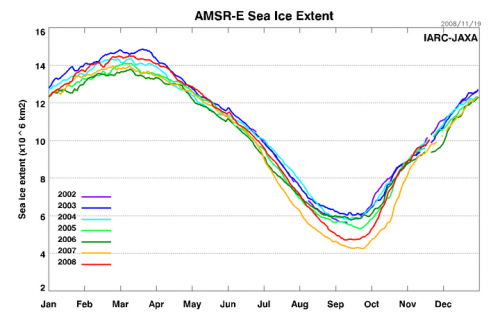
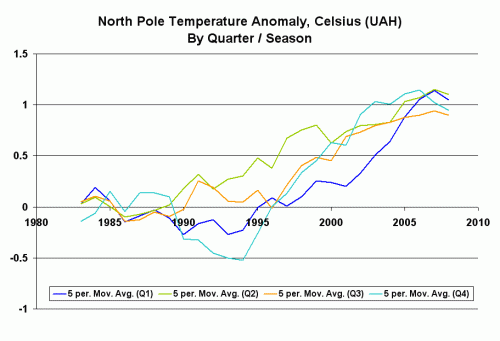
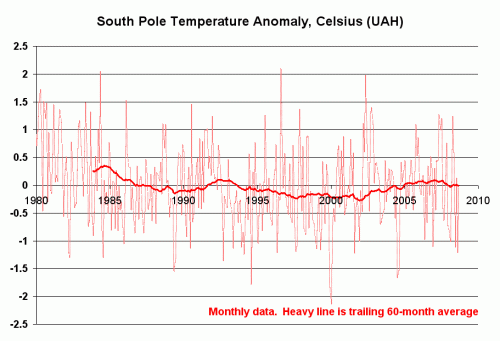
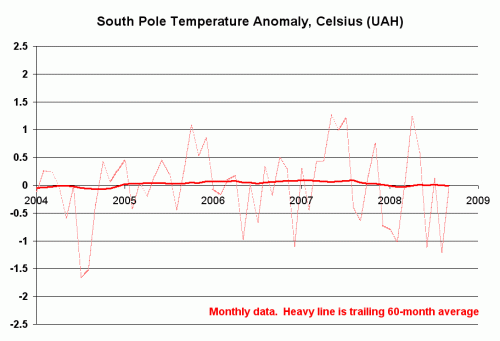
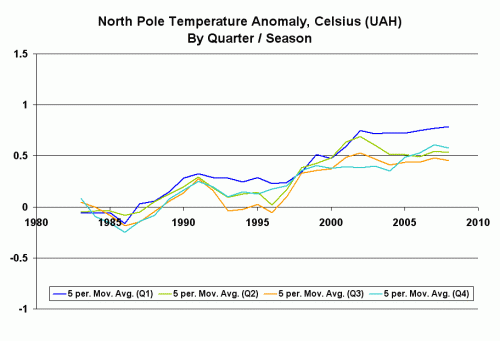
Svensmark considers the fact that Antarctica’s temperatures generally run counter to the rest of the world as evidence in favor of the Cosmic Ray theory.
http://arxiv.org/PS_cache/physics/pdf/0612/0612145v1.pdf
In general, more cosmic rays lead to more clouds, and the earth general gets cooler. Fewer cosmic rays leads to less cloudiness, and the earth gets warmer.
Antarctica’s ice cap has a very high albedo. When the earth as a whole gets warmer, that icecap becomes cloud free, and reflects away more sunlight, and becomes cooler. When the earth as a whole gets cooler, Antarctica gets warmer. There are more clouds over Antarctica, which have a lower albedo than the icecap, and also trap heat radiated from the surface.
I don’t now if the models originally said this, or if it was observed that the poles were warming more so it was thereafter built into the models: the first models that predicted polar amplification were described in the late 1970s. Good observations of the polar regions started at about the same time.
Climate scientists now argue that by “polar amplification” they really only meant the North Pole. The South Pole is different, say some scientists (and several comm enters on this blog) because the larger ocean extent in the Southern Hemisphere has always made it less susceptible ot temperature variations: your characterisation of what climate scientists now argue is way off. Models which run to equilibrium give roughly equal amplification at both poles. Transient models (more resource intensive and thus later to arrive on the scene) show that the north pole is expected to warm much sooner than the south pole, in response to a forcing. There has been no U-turn such as you imply.
If polar amplification were occurring and the explanation for the North Pole warming more than the rest of the Earth (by far) over the last 30 years, shouldn’t I see it in the seasonal data. I am honestly curious, and would like comments.: seems to me quite plausible that the increasing summer melt would tend to lead to summer temperatures rising quicker than winter temperatures. But increasing CO2 normally leads to winter temperatures rising more rapidly than summer temperatures – something that is clearly observed in the rest of the world. So, perhaps in the Arctic the two effects are more or less cancelling each other out.
Given that this was written in 2004, he means restricted to 1984-2004. Unlike global warming?: yes, unlike global warming. That has been observed for a much longer period.
By the way, he would see it for much longer than 20 years if these NASA scientists were not so hostile to space technologies (ie satellite measurement): this statement makes no sense.
wouldn’t life be so much better at NASA without satellites? – again, bizarre comment. What do you mean?
This is roughly what one would predict from CO2 global warming (or other natural forcings, by the way). The most warming is in the winter: you wouldn’t expect that from an increase in solar radiation.
The large parts of NASA that have been co-opted by AGW promoters are having trouble keeping those pesky satellite data under control.
That is a huge irony: AGW is destroying NASA’s science mission in its effort to impose a revolution.
I think the difference between the Arctic and Antarctic ice is driven in large part by two factors. The presence of more soot in the north is one. The sea ice in the south is deeply influenced by huge non-floating ice sources.
Thought you may be interested in this. Note the absence of records during the War period. I guess they had more important things on their mind.
http://www.cefas.co.uk/data/sea-temperature-and-salinity-trends/presentation-of-results/station-18-dover.aspx
Keep up the good work
The AGW propaganda machine rolls on: http://www.cnn.com/2008/TECH/science/11/21/climate.danger.zone/index.html
The CNN article contains the following statement: Dr Hansen told CNN: “In the paleoclimate data, the Cenozoic data is the most alarming — burning all the fossil fuels clearly would send the planet back to the ice-free state with sea level about 250 feet higher.”
If only the media was a watch dog, not a lap dog.
Josh,
Historians will look back at Hansen- his work, his vocabulary, his body language, his associations- and wonder why he was not seen through immediately.